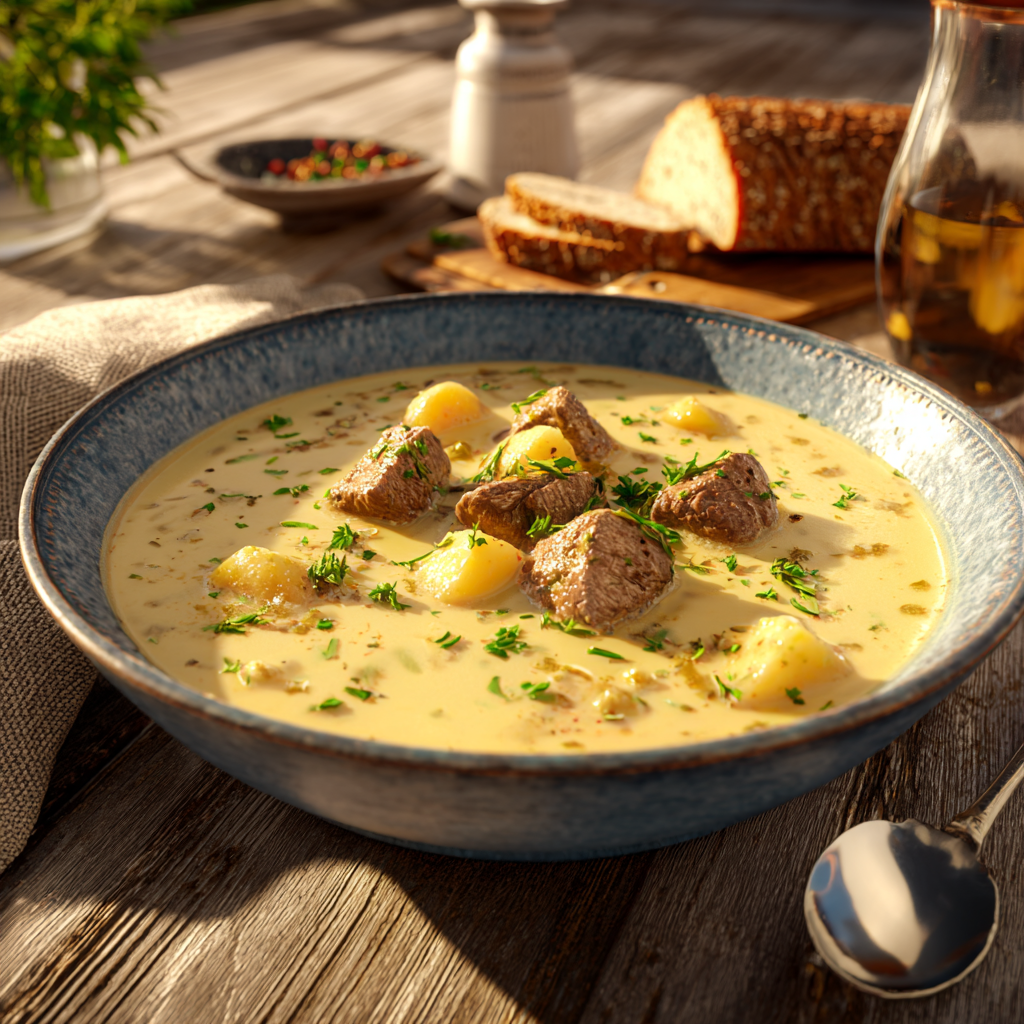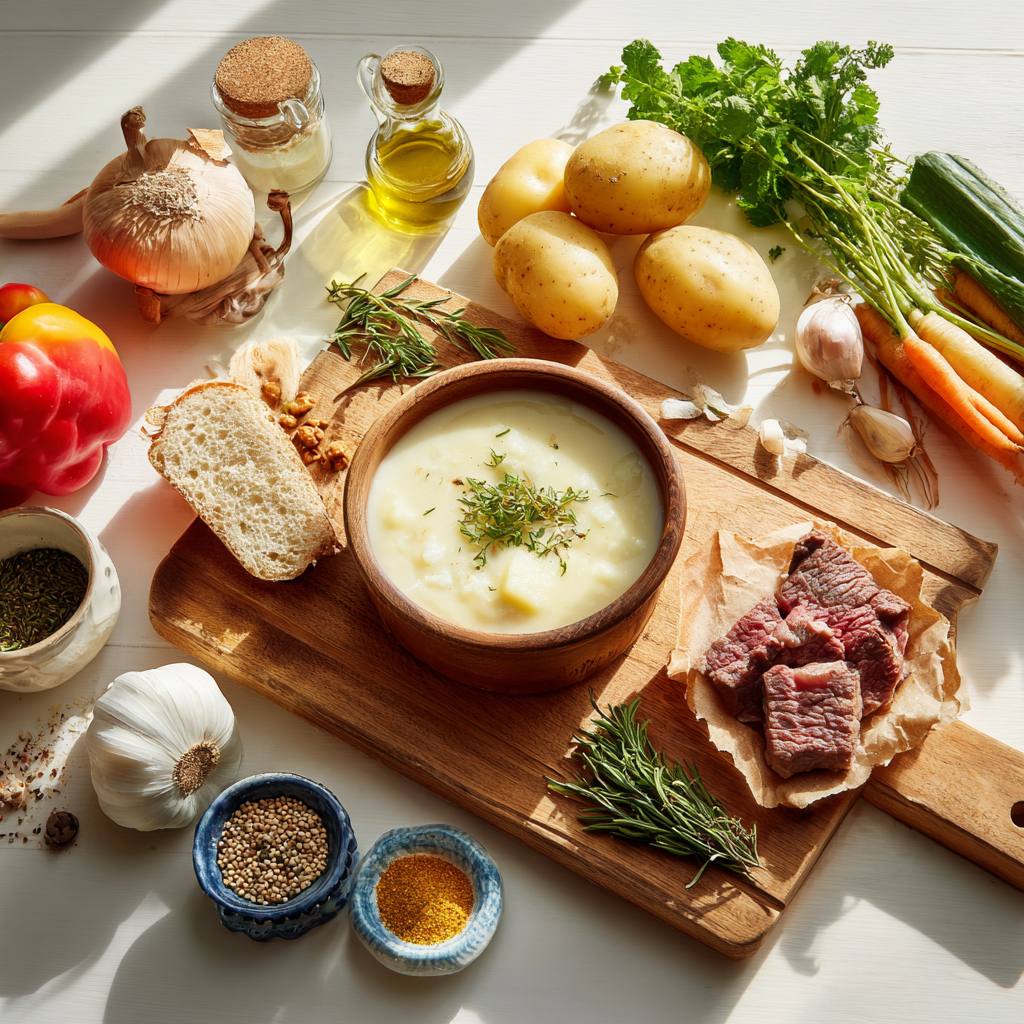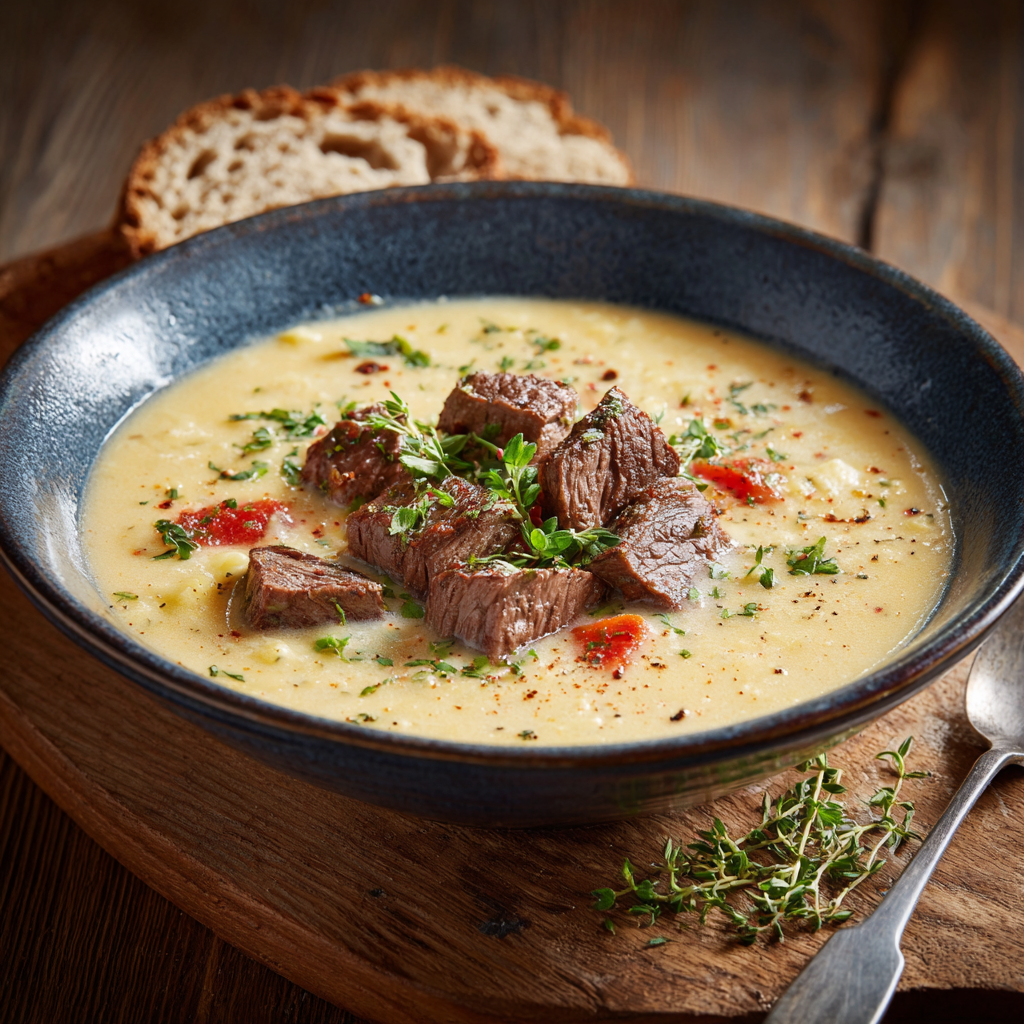
Introduction
I still remember the first time I tried Outback Steakhouse’s potato soup. It was creamy, comforting, and bursting with flavor—like a warm hug in a bowl. That soup became my go-to order every time I visited. Over the years, I found myself craving it more often than my budget allowed. That’s when I decided to recreate the outback steakhouse potato soup recipe at home. Not only did I save money, but I also discovered how easy it is to make this restaurant-quality dish in my own kitchen.
If you’re like me and love hearty, flavorful soups, you’re in for a treat. In this article, I’ll walk you through step-by-step instructions to make this iconic soup. You’ll also get helpful tips, answers to common questions, and insights into why this recipe is a must-try for any home cook.
Why This Outback Steakhouse Potato Soup Recipe is a Must-Try
There’s something magical about making soup at home. Maybe it’s the aroma that fills the house or the satisfaction of creating something delicious from scratch. For me, it’s both. The outback steakhouse potato soup recipe quickly became a favorite because it’s simple yet packed with layers of flavor. Every spoonful reminds me of cozy family dinners and lazy Sunday afternoons.
What makes this soup stand out? It’s all about the balance of creamy potatoes, savory bacon, and a hint of spice. These flavors come together to create a dish that’s rich but not overwhelming. Whether you’re cooking for your family or hosting a gathering, this soup fits perfectly. It’s versatile enough to serve as a starter or even as a main course paired with crusty bread.
Key Ingredients You’ll Need
To nail the authentic taste of this soup, you’ll need a handful of essential ingredients. Each one plays a key role in bringing the dish to life. Here’s what you’ll need:
- Potatoes: The star of the show. Use russet or Yukon gold potatoes for the best texture.
- Bacon: Adds a smoky, salty flavor that complements the creaminess of the soup.
- Onion and Garlic: These aromatics build the base flavor of the soup.
- Chicken Broth: Provides depth and richness to the broth.
- Heavy Cream: Makes the soup luxuriously creamy without being too heavy.
- Cheese: Sharp cheddar melts beautifully and adds a tangy kick.
- Butter and Flour: Used to create a roux, which thickens the soup.
- Spices: A pinch of cayenne pepper or paprika gives the soup a subtle warmth.
Each ingredient matters. For example, using real bacon instead of pre-cooked bits gives the soup a deeper smoky flavor. Similarly, fresh garlic beats garlic powder any day. Don’t skip the roux—it’s what makes the soup velvety smooth. If you’ve ever wondered why restaurant soups taste so rich, it’s often because of this simple step.
One tip I’ve learned: don’t overcook the potatoes. They should be tender but still hold their shape. Overcooked potatoes can make the soup too starchy and change the texture. Another trick is to shred the cheese finely. This helps it melt evenly into the soup without clumping.
With these ingredients and tips, you’re well on your way to making a batch of outback steakhouse potato soup recipe that rivals the original. Stick around, and I’ll guide you through the process step by step. You’ll see just how easy it is to bring this classic dish to life in your own kitchen.

Step-by-Step Guide to Making Outback Steakhouse Potato Soup
Alright, let’s get into the nitty-gritty of how to whip up this creamy, dreamy soup. By now, you’ve got your ingredients ready, so it’s time to dive in. Trust me, once you start cooking, the aroma alone will make you want to skip ahead and dig in. But patience is key here—good things come to those who wait (and stir).
Preparing Your Base
First things first: we’re building the foundation of this soup. Think of it like laying down tracks for a train—it’s gotta be solid. Start by peeling and dicing your potatoes. I usually go for russets because they’re starchy enough to give the soup body but not so starchy that it turns gluey. Yukon golds work too if you prefer something a bit creamier.
Once your potatoes are prepped, toss them into a pot with chicken broth. This is where the magic begins. The broth adds depth and richness, kind of like how a good playlist sets the mood for a dinner party. Let it simmer gently while you focus on thickening the soup. If you’re wondering how to thicken outback steakhouse potato soup, don’t stress—it’s easier than you think. Just grab some butter and flour, whisk them together in a separate pan to make a roux, and then slowly incorporate it into the simmering liquid. It’ll transform from watery to velvety smooth in no time.
Oh, and here’s a little tip: keep an eye on the heat. You don’t want it boiling aggressively; otherwise, the potatoes might break apart too much. A gentle simmer is all you need. Speaking of which, if you’re ever unsure about whether your soup’s texture is right, check out my guide on 4bs tomato soup recipe. It’s got some great pointers on achieving that perfect consistency.
Adding Layers of Flavor
Now comes the fun part—layering in those bold flavors. Bacon is non-negotiable here. Fry it up until it’s crispy, then crumble it into bits. Funny enough, I always save a few pieces to sprinkle on top as garnish later. Adds a nice crunch, ya know?
Next, sauté some onions and garlic in the leftover bacon grease. Why waste such delicious flavor? These aromatics are what give the soup its backbone. People often ask, “What spices are used in Outback Steakhouse potato soup?” Well, besides the smoky notes from the bacon, I like to toss in a pinch of cayenne pepper and smoked paprika. They add just enough warmth without overpowering everything else. Oh, and don’t forget the cheese! Sharp cheddar melts beautifully and brings a tangy edge that balances out the creaminess.
By the way, if you’re catering to dietary preferences, there are ways to tweak this recipe. For vegetarians, swap the bacon for smoked tofu or even roasted mushrooms. And instead of chicken broth, try vegetable stock. Honestly, it still tastes amazing—I promise. If you’re looking for more vegetarian inspiration, my Carrabba’s sausage and lentil soup recipe has some creative ideas worth exploring.
Simmering and Perfecting the Soup
At this point, your kitchen probably smells incredible. But resist the urge to serve it immediately. Simmering is crucial—it’s what allows all those flavors to mingle and deepen. Here’s the thing: rushing this step is like skipping straight to dessert without enjoying the main course. Give it at least 20 minutes over low heat. Stir occasionally to prevent sticking, especially near the bottom of the pot.
While it simmers, keep an eye out for visual cues. The soup should look thick and creamy, almost like a hug in liquid form. If it seems too thin, let it reduce a bit longer. On the flip side, if it’s thicker than you’d like, add a splash of milk or broth to loosen it up. This is where knowing the best way to cook outback steakhouse potato soup really pays off. It’s all about finding that sweet spot between hearty and light.
Here’s a random thought: have you ever noticed how soups taste better the next day? Something about letting it sit overnight allows the flavors to develop even further. So if you can resist devouring it immediately, store some in the fridge and reheat it tomorrow. You won’t regret it. In fact, this reminds me of another recipe I love—the Max and Erma’s tortilla soup recipe. That one also benefits from a little resting time before serving.
Finally, taste and adjust the seasoning. Sometimes a dash of salt or a squeeze of lemon juice can elevate the entire dish. Once you’re happy with the flavor, ladle it into bowls and top it off with shredded cheese, extra bacon, or even green onions for freshness. If you’re feeling fancy, drizzle a bit of sour cream on top. It’s optional, but trust me—it makes it Instagram-worthy.
And hey, if life gets hectic and you need something quicker, my busy day soup recipe is a lifesaver. It’s not quite as indulgent as this one, but it’s perfect for when you need comfort food fast.
There you have it—a foolproof guide to making Outback Steakhouse potato soup at home. Whether you stick to the classic version or experiment with variations, this soup is bound to become a staple in your recipe rotation. Now go ahead, grab that spoon, and enjoy every bite!

Tips for Serving and Storing Your Potato Soup
Alright, so you’ve nailed the recipe. The soup is creamy, flavorful, and ready to be devoured. But hold up—how you serve and store it can make all the difference. Trust me, I’ve learned a thing or two over the years about taking this dish from good to absolutely unforgettable.
Creative Serving Ideas
Let’s talk presentation. Sure, you could just plop the soup in a bowl and call it a day, but why not elevate the experience? Pairing your outback steakhouse potato soup recipe with some crusty bread or a side salad turns it into a full meal that feels fancy without much effort. One of my go-to combos is a warm baguette slathered with garlic butter—it’s simple, but oh-so-satisfying. For something lighter, try a crisp arugula salad with lemon vinaigrette. The peppery greens balance out the richness of the soup perfectly.
By the way, if you’re hosting friends or family, serving the soup in mini bread bowls is always a hit. It’s a little extra work, sure, but people love the novelty of eating their soup straight out of a hollowed-out loaf. Plus, it makes cleanup easier since everyone eats the “bowl” too. Bonus points if you sprinkle fresh herbs like chives or parsley on top for a pop of color.
Can You Freeze Outback Steakhouse Potato Soup?
This is a question I get all the time: “Can you freeze Outback Steakhouse potato soup?” The short answer? Yes, but there are a few things to keep in mind. Freezing works best if you haven’t added dairy yet. See, cream-based soups can sometimes separate when thawed, leaving you with a grainy texture. If you know you’ll want leftovers later, set aside a portion before stirring in the heavy cream or cheese. Then, when you’re ready to reheat, add those ingredients at the end.
Here’s how I do it: let the soup cool completely, then pour it into freezer-safe containers or zip-top bags. Label them with the date because, trust me, you don’t want mystery meals lurking in your freezer six months later. When you’re ready to eat, thaw it overnight in the fridge and gently reheat on the stovetop. Add a splash of milk or broth if needed to loosen it up.
Storage Tips for Keeping Leftovers Fresh
If freezing isn’t your thing, no worries—this soup keeps beautifully in the fridge for up to four days. Just store it in an airtight container to lock in moisture and prevent it from absorbing other smells (looking at you, leftover garlic). Reheating is easy; just warm it slowly on low heat while stirring occasionally. Avoid boiling it again, though, as that can break down the potatoes further and alter the texture.
Funny enough, I once forgot about a batch of soup in the back of my fridge for five days. Against all odds, it still tasted amazing—but please, don’t follow my example. Stick to the four-day rule unless you’re feeling adventurous!
Common Questions About Outback Steakhouse Potato Soup
Over the years, I’ve fielded plenty of questions about this beloved soup. Let’s tackle some of the most common ones here. Whether you’re tweaking the recipe or troubleshooting, these answers should help you out.
FAQ Section
- Is Outback Steakhouse potato soup gluten-free?
Unfortunately, no—at least not in its traditional form. The roux made from flour and butter contains gluten, which thickens the soup. But don’t despair! You can easily swap the flour for cornstarch or a gluten-free flour blend to achieve the same velvety texture. Just mix the cornstarch with cold water first to avoid clumping. - How do you reheat leftover potato soup without losing flavor?
Slow and steady wins the race here. Heat it on low on the stovetop, stirring often to distribute the heat evenly. Microwaving works too, but do it in short bursts and stir between each one to prevent hot spots. Adding a splash of milk or broth helps revive the original consistency. - What can I substitute for bacon?
For vegetarians or those avoiding pork, smoked paprika or liquid smoke adds a similar depth. Roasted mushrooms or even crispy chickpeas can mimic the texture and savoriness of bacon. Experiment and see what works for you! - Why does my soup taste bland?
Chances are, it needs more seasoning. Don’t be shy with the salt and pepper—they really bring out the flavors. A squeeze of lemon juice or a dash of hot sauce can also brighten things up. Taste as you go, and adjust accordingly. - Can I use pre-shredded cheese?
Technically, yes, but I’d advise against it. Pre-shredded cheese often contains anti-caking agents that can affect melting. Grating your own block of sharp cheddar ensures smoother results and better flavor. - How can I make the soup spicier?
Love a kick? Increase the cayenne pepper or toss in a diced jalapeño while sautéing the onions. A drizzle of sriracha on top before serving also does wonders. Adjust to your spice tolerance! - What type of potatoes works best?
Russets are ideal due to their high starch content, which thickens the soup naturally. Yukon golds are another great option if you prefer a creamier texture. Avoid waxy varieties like red potatoes, as they won’t break down as well. - Should I peel the potatoes?
Peeling gives the soup a smoother appearance, but leaving the skins on adds rustic charm and extra nutrients. It’s totally up to you—just scrub them clean either way. - Why did my soup turn out too thick?
No biggie! Simply stir in a bit more broth, milk, or water until it reaches your desired consistency. Soups thicken as they sit, so this is pretty common. - Can I prep this ahead of time?
Absolutely! In fact, making the base a day in advance lets the flavors meld even more. Store it in the fridge and finish with cream and cheese right before serving. Talk about stress-free entertaining!
If you’re hungry for more inspiration, check out our collection of soups, stews, and chili recipes. There’s something for every season and mood!
Final Thoughts
You know, there’s something incredibly satisfying about mastering a recipe like this outback steakhouse potato soup recipe. It’s not just about recreating a favorite dish—it’s about making memories around the table. Maybe you’ll tweak it to suit your family’s tastes or pass it along to a friend who loves comfort food. Whatever you do, embrace the process and have fun with it.
Go ahead, experiment with your own twists while staying true to the heart of the dish. Who knows? You might just create a new tradition. And hey, I’d love to hear how it turns out! Drop a comment below and share your experience—I’m always here to chat about good food.

Outback Steakhouse Potato Soup Recipe
Ingredients
Equipment
Method
- 1. Peel and dice the potatoes.
- 2. Combine diced potatoes and chicken broth in a pot and bring to a gentle simmer.
- 3. In a separate pan, melt butter and whisk in flour to create a roux.
- 4. Slowly incorporate the roux into the simmering potatoes and broth until thickened.
- 5. Fry the bacon until crispy, then crumble it into bits.
- 6. Sauté diced onion and minced garlic in the bacon grease until soft.
- 7. Add the bacon, sautéed onion, garlic, cayenne pepper, and smoked paprika to the soup.
- 8. Stir in heavy cream and shredded cheddar cheese until melted.
- 9. Simmer the soup for at least 20 minutes, stirring occasionally.
- 10. Adjust seasoning with salt and pepper.
- 11. Serve hot, garnished with extra bacon, cheese, and green onions if desired.
- * For a gluten-free option, substitute flour with cornstarch mixed with water.
- * To freeze, set aside a portion before adding cream and cheese, then add them when reheating.
- * This soup tastes even better the next day, so consider making it ahead of time.
- * Pair with crusty bread or a side salad for a full meal.
